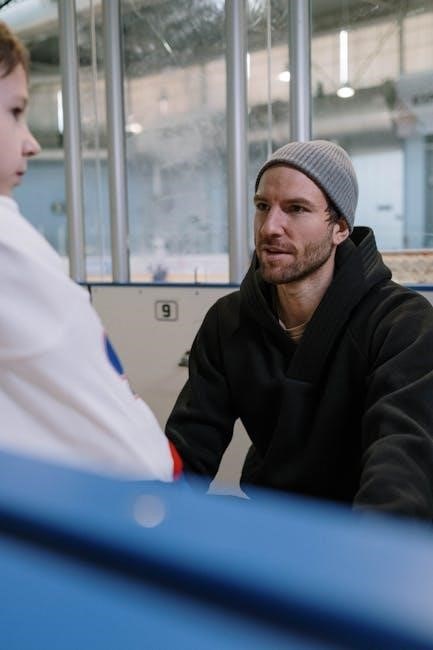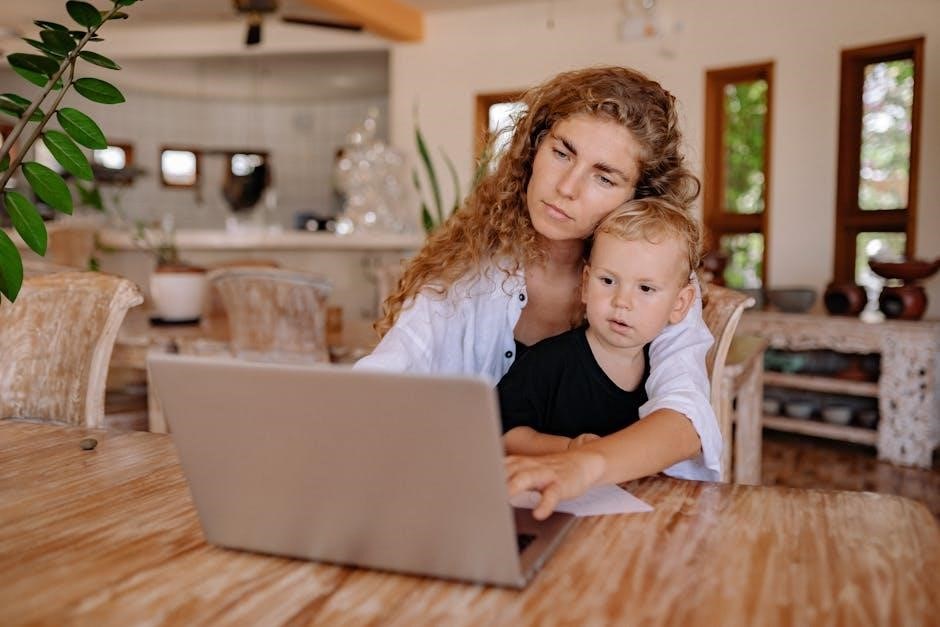the ultimate kids guide to dogs
Discover the best tips, fun facts, and essential care advice for kids who love dogs. Learn how to be a responsible dog owner!
Welcome to the fascinating world of dogs! Discover how these loyal companions bring joy‚ friendship‚ and endless adventure into your life. Learn why dogs make amazing pets‚ how to care for them‚ and the special bond you can share. This guide is perfect for kids and families‚ offering fun facts‚ tips‚ and activities to help you understand and love your furry friend even more!
1.1 Welcome to the World of Dogs
Welcome to the amazing world of dogs! Dogs are loyal friends‚ full of energy and love‚ bringing joy to families everywhere. Whether you’re a seasoned dog owner or just starting to learn‚ this guide will help you understand these incredible pets. Discover why dogs are such special companions‚ how to care for them‚ and the exciting adventures you can share. From playful pups to gentle giants‚ dogs offer endless fun and learning opportunities for kids of all ages!
1.2 Why Dogs Make Great Pets
Dogs make great pets because they are loyal‚ loving‚ and always excited to see you! They help kids develop social skills‚ teach responsibility‚ and provide endless companionship. Whether you’re playing fetch or cuddling on the couch‚ dogs bring joy and laughter into your life. They also encourage outdoor adventures and active play‚ helping families stay healthy and connected. With their unique personalities and affectionate nature‚ dogs truly become part of the family‚ offering love and friendship that lasts a lifetime.
1.3 Safety First: Understanding Dog Behavior
Understanding dog behavior is key to keeping everyone safe and happy. Dogs thrive in controlled‚ comfortable environments‚ and introducing them to kids properly is essential. Teach kids to read body language‚ like wagging tails for excitement or tucked tails for fear. Always supervise interactions and ensure kids know not to tease or disturb a dog while eating or sleeping; By teaching gentle approaches and respect‚ you can prevent accidents and build a harmonious home for both kids and dogs.

Understanding Dog Behavior
Dogs communicate in amazing ways! Learn how they use body language‚ sounds‚ and actions to express emotions. Understanding these cues helps kids build trust and ensure safe interactions with their furry friends.
2.1 How Dogs Communicate
Dogs communicate in fascinating ways! They use body language‚ sounds‚ and even scent to express emotions and needs. A wagging tail can show happiness or excitement‚ while a tucked tail might signal fear. Barking‚ whining‚ and growling are vocal cues that convey messages like excitement‚ anxiety‚ or warning. Pawing‚ licking‚ and leaning are physical gestures that also speak volumes. Understanding these signals helps kids build trust and ensure safe‚ fun interactions with their furry friends. It’s like learning a new language to become a better dog buddy!
2.2 Reading a Dog’s Body Language
Dogs express emotions through body language! A wagging tail can mean excitement‚ while a tucked tail might show fear. Ears up indicate confidence‚ but laid-back ears can signal anxiety. Pawing or licking may mean your dog is nervous or seeking attention. Even scars or limping can hint at past experiences. Learning these signs helps kids understand their dog’s feelings and needs‚ making interactions safer and more meaningful. Paying attention to body language is key to building a strong‚ trusting bond with your furry friend!
2.3 Common Dog Behaviors Explained
Dogs often exhibit behaviors that might seem puzzling but are natural! Barking usually signals excitement‚ alertness‚ or anxiety. Chewing is a way dogs explore their world‚ while digging can be a sign of boredom or instinct. Licking may indicate affection or stress. Understanding these behaviors helps kids respond appropriately. For example‚ offering a toy when your dog starts chewing or providing exercise if they’re digging. Knowing why dogs act certain ways makes it easier to guide them and build trust!

Preparing Your Home for a Dog
Get your home ready for a furry friend! Secure harmful items‚ create a cozy space‚ and gather essential supplies like bowls and toys. Involve kids in setting up‚ teaching them safe interactions and gentle care. This ensures a smooth transition for both your family and the new dog!
3.1 How to Dogify Your House
Transform your home into a dog-friendly space! Start by removing hazardous items and securing toxic substances. Create a cozy corner for your dog with a soft bed and toys. Involve kids in setting up a safe zone‚ free from breakables. Teach them to store food and trash securely. Make sure stairs are gated if needed‚ and block off areas you want off-limits. This creates a safe‚ welcoming environment for your furry friend and ensures a smooth transition for the whole family!
3.2 Essential Supplies for Your Dog
Get ready to welcome your furry friend with the right gear! Start with a comfy dog bed and a cozy blanket. Your dog will need a variety of toys‚ like chew toys and plushies‚ to keep them entertained. A sturdy leash‚ collar‚ and ID tag are must-haves for walks. Don’t forget a food bowl‚ water bowl‚ and high-quality dog food tailored to their age and size. Grooming tools like a brush and nail clippers are also essential. Treats for training and a first-aid kit will come in handy too. Involve the kids in picking out fun supplies—it’s a great way to get them excited about caring for your new pet!
3.3 Safety Tips for Kids and Dogs
Teach kids to approach dogs calmly and gently. Always supervise interactions between children and dogs. Show kids how to let a dog sniff their hand before petting. Avoid sudden movements or loud noises‚ as they can scare the dog; Teach children not to tease or pull a dog’s ears or tail. Ensure kids understand to never disturb a dog while it’s eating or sleeping. Keep small toys and treats out of reach to avoid conflicts. Most importantly‚ teach kids to respect a dog’s personal space and boundaries for a safe and happy friendship!

Training Your Dog
Training your dog is fun and rewarding! Teach basic commands‚ use positive reinforcement‚ and make it a game. Consistency and patience help your dog learn fast. Involve kids in training for a strong bond and lasting success.
4.1 The Importance of Training
Training your dog is essential for building a strong bond and ensuring good behavior. It helps with communication‚ keeps your dog safe‚ and strengthens trust. Consistency and patience are key. Training teaches your dog to listen‚ obey commands‚ and behave well in public. It also prevents unwanted habits and keeps everyone happy. Kids can join in‚ learning responsibility and how to interact positively with their furry friend. A well-trained dog is a joy to be around‚ making life easier and more fun for the whole family.
4.2 Basic Commands Every Dog Should Know
Teaching your dog basic commands is fun and rewarding! Start with simple ones like “sit‚” “stay‚” and “come.” These help keep your dog safe and well-behaved. “Leave it” stops unwanted behavior‚ while “heel” makes walks easier. Use treats and praise to encourage learning. Dogs love pleasing their owners‚ and these commands create a strong bond. Kids can help teach these basics‚ making it a great way to involve the whole family in your dog’s training. Consistency is key to helping your dog master these essential skills!
4.3 Fun Tricks to Teach Your Dog
Teach your dog fun tricks like “shake hands” or “roll over” for endless entertainment! Start with simple tricks using treats and praise. Kids can help teach “spin” or “jump through a hoop‚” making it a family activity. Advanced tricks like “play dead” or “fetch” challenge your dog and strengthen your bond. These tricks are not only fun but also keep your dog mentally stimulated. With patience and practice‚ your dog will become a star performer‚ impressing everyone with their cool skills!

Dog Healthcare 101
Keep your dog healthy with regular vet check-ups‚ vaccinations‚ and parasite control; Learn about proper nutrition‚ grooming‚ and dental care to ensure your furry friend thrives happily!
5.1 Routine Care for Your Dog
Routine care is essential for keeping your dog healthy and happy. Regular vet check-ups ensure your dog stays up-to-date on vaccinations and parasite control. Proper nutrition is key—choose high-quality dog food suited to their age and size. Daily grooming helps maintain their coat and overall hygiene. Don’t forget dental care‚ as healthy teeth are vital for your dog’s well-being. Establishing a consistent routine‚ including daily walks and playtime‚ will keep your furry friend thriving and strong!
5.2 Signs of Illness to Watch For
Keep an eye out for changes in your dog’s behavior or physical condition that may signal illness. Vomiting‚ diarrhea‚ or lack of appetite can indicate something’s wrong. Lethargy‚ excessive drooling‚ or difficulty breathing are red flags. Check for visible signs like red eyes‚ limping‚ or unusual odors. If your dog shows these symptoms‚ consult a vet immediately. Early detection and care can make a big difference in helping your furry friend feel better and stay healthy!
5.3 The Role of Veterinarians
Veterinarians are essential for keeping your dog healthy and happy. They provide expert care‚ diagnose illnesses‚ and offer advice on nutrition and safety. Regular check-ups with a vet help prevent health issues and ensure your dog gets the right vaccinations. If your dog ever gets sick or hurt‚ a vet can provide the treatment they need to recover. Building a good relationship with a vet is key to giving your dog the best life possible!

Introducing Dogs to Kids
Introducing dogs to kids requires patience and care to ensure a smooth‚ safe experience for both. Start in a calm‚ controlled environment to build trust and confidence.
6.1 How to Introduce Dogs to Kids
Introducing dogs to kids requires a calm and controlled environment to ensure safety and comfort for both. Start by letting the dog and child meet in a neutral area‚ allowing them to sniff and explore at their own pace. Always supervise interactions and teach kids to move slowly and gently around dogs. Reward positive behavior with treats or praise to build trust. This gradual approach helps create a strong‚ friendly bond between your child and the dog.
6.2 Teaching Kids to Interact Safely
Teach kids to interact with dogs safely by showing them how to move calmly and gently. Demonstrate proper techniques‚ like letting the dog approach first and avoiding sudden movements. Explain the importance of not pulling tails or ears and respecting the dog’s personal space. Encourage kids to ask permission before petting and to watch for signs of discomfort in the dog‚ such as raised hackles or avoiding eye contact. Positive reinforcement‚ like praising gentle behavior‚ helps kids develop respectful habits around dogs.
6.3 Building a Strong Bond
Building a strong bond between kids and dogs starts with shared activities and mutual respect. Encourage kids to spend quality time with their dog‚ such as playing fetch‚ going on walks‚ or simply cuddling. Teach them to be consistent‚ patient‚ and kind‚ as these traits foster trust and loyalty. Involve kids in daily care routines‚ like feeding or grooming‚ to help them feel responsible and connected. Positive reinforcement‚ like praise or treats‚ strengthens the bond and creates lasting memories for both kids and dogs.

Fun Activities with Dogs
Engage in exciting outdoor games‚ crafts‚ and interactive projects that strengthen your bond with your dog. From obstacle courses to scavenger hunts‚ these activities ensure endless fun and learning for kids and dogs alike!
7.1 Crafts and Projects for Dog Lovers
Engage your creativity with fun crafts and projects designed for dog enthusiasts! From making homemade dog toys to crafting cozy dog beds‚ these activities are perfect for kids. Create a doggy piñata‚ design personalized collars‚ or build interactive games that your furry friend will love. These hands-on projects not only foster creativity but also teach kids about responsibility and compassion for their pets.
7.2 Outdoor Games to Play with Your Dog
Get ready for exciting outdoor adventures with your furry friend! Play fetch‚ hide-and-seek‚ or tug-of-war to keep your dog active and happy. Create a DIY obstacle course or try frisbee for a fun challenge. These games not only provide exercise but also strengthen your bond. Teach your dog to fetch sticks‚ run races‚ or even swim if they love water. Outdoor playtime is a great way to explore nature and keep your dog entertained while learning new skills together!
7.3 How Kids Can Help Care for Their Dog
Kids can play a big role in caring for their dog! They can help with feeding‚ refilling water‚ and even grooming. Teach them to brush the dog gently or wipe its paws. Older kids can assist with walking or playing fetch. Simple tasks like making a dog bed or crafting toys using safe materials are fun and creative. Encourage kids to observe their dog’s behavior and report any changes. This teaches responsibility and helps kids bond with their furry friend while learning important caregiving skills!

